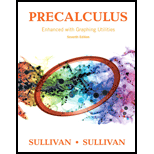
Precalculus Enhanced with Graphing Utilities (7th Edition)
7th Edition
ISBN: 9780134119281
Author: Michael Sullivan, Michael Sullivan III
Publisher: PEARSON
expand_more
expand_more
format_list_bulleted
Concept explainers
Question
Chapter B, Problem 24SB
To determine
To find: Determine whether each sequence converges or diverges. If it converges, find its limit.
Expert Solution & Answer
Want to see the full answer?
Check out a sample textbook solution
Students have asked these similar questions
Solve ASAP
Book Problem 15
Determine whether the sequence is divergent or convergent. If it is convergent, evaluate its limit. If it diverges to infinity, state your answer as "INF" (without the
quotation marks). If it diverges to negative infinity, state your answer as "MINF". If it diverges without being infinity or negative infinity, state your answer as
"DIV".
an=
b₁ =
(-1)"n³
2n5+8n² + 2
(-1)"n7
2n7+8n²+2
Problem 2. Let {a, }, be a sequence of real numbers defined by
2n+1
a1 = 1, an
an-1, n= 2,3,4,
3n
Show that the sequence {a, }n converges and find its limit.
Chapter B Solutions
Precalculus Enhanced with Graphing Utilities (7th Edition)
Ch. B - If a sequence { S n } converges to L , we call L...Ch. B - If a 1 , a 2 ,..., a n ,... is some collection of...Ch. B - Prob. 3CVCh. B - Prob. 4CVCh. B - Prob. 5SBCh. B - Prob. 6SBCh. B - In Problems 5-28, determine whether each sequence...Ch. B - In Problems 5-28, determine whether each sequence...Ch. B - In Problems 5-28, determine whether each sequence...Ch. B - Prob. 10SB
Ch. B - Prob. 11SBCh. B - In Problems 5-28, determine whether each sequence...Ch. B - In Problems 5-28, determine whether each sequence...Ch. B - In Problems 5-28, determine whether each sequence...Ch. B - Prob. 15SBCh. B - Prob. 16SBCh. B - Prob. 17SBCh. B - In Problems 5-28, determine whether each sequence...Ch. B - Prob. 19SBCh. B - In Problems 5-28, determine whether each sequence...Ch. B - Prob. 21SBCh. B - Prob. 22SBCh. B - Prob. 23SBCh. B - Prob. 24SBCh. B - Prob. 25SBCh. B - Prob. 26SBCh. B - In Problems 5-28, determine whether each sequence...Ch. B - In Problems 5-28, determine whether each sequence...Ch. B - In Problems 29-32, find the first five terms in...Ch. B - In Problems 29-32, find the first five terms in...Ch. B - Prob. 31SBCh. B - In Problems 29-32, find the first five terms in...
Additional Math Textbook Solutions
Find more solutions based on key concepts
1. How many solutions are there to ax + b = 0 with ?
College Algebra with Modeling & Visualization (5th Edition)
8. Effect of Blinding Among 13,200 submitted abstracts that were blindly evaluated (with authors and institutio...
Elementary Statistics
An elevator starts at the basement with 8 people (not including the elevator operator) and discharges them all ...
A First Course in Probability (10th Edition)
Identifying a Test In Exercises 21–24, determine whether the hypothesis test is left-tailed, right-tailed, or t...
Elementary Statistics: Picturing the World (7th Edition)
For a population containing N=902 individual, what code number would you assign for a. the first person on the ...
Basic Business Statistics, Student Value Edition
CHECK POINT I You deposit $1000 in a saving account at a bank that has a rate of 4%. a. Find the amount, A, of ...
Thinking Mathematically (6th Edition)
Knowledge Booster
Learn more about
Need a deep-dive on the concept behind this application? Look no further. Learn more about this topic, calculus and related others by exploring similar questions and additional content below.Similar questions
- SOLVE STEP BY STEP IN DIGITAL FORMATarrow_forwardProblem 6. Prove or disprove each of the statements. (a) The sequence xn = (-1)" is convergent. (b) The sequence xn (-1)" is convergent. (c) Let (xn) be a sequence such that the sequence |xn| of absolute values converges. Then (xn) converges. (d) Let (xn) and (yn) be two unbounded sequences. Then the product sequence (xn • Yn) is unbounded.arrow_forwardAnswer the following problems directly. 1-Let F(n) be the nth term of the Fibonacci sequence, With F(1) = 1, F(2) = 1, F(3) = 2, and so on. %3D %3D 1. Find F (8) 2. Find F(19) 3. IfF (22) = 17,711 and F(24) = 46,368, %3D what is F(23)?arrow_forward
- 5. Give a summation-free formula for the ordinary and exponential generating functions for each sequence. (a) an = (-1)". (This sequence alternates 1, −1, 1, −1, … …..) (b) bn = n. (This sequence begins 0, 1, 2, 3,... and continues on forever. For both functions, you may want to factor an x out of the infinite sum.)arrow_forwardFind a closed form solution for the following recursive sequence: An = an-1+ 2" for n > 2 with the initial condition aj = 1. An =arrow_forward1arrow_forward
arrow_back_ios
arrow_forward_ios
Recommended textbooks for you
 Glencoe Algebra 1, Student Edition, 9780079039897...AlgebraISBN:9780079039897Author:CarterPublisher:McGraw Hill
Glencoe Algebra 1, Student Edition, 9780079039897...AlgebraISBN:9780079039897Author:CarterPublisher:McGraw Hill Algebra for College StudentsAlgebraISBN:9781285195780Author:Jerome E. Kaufmann, Karen L. SchwittersPublisher:Cengage Learning
Algebra for College StudentsAlgebraISBN:9781285195780Author:Jerome E. Kaufmann, Karen L. SchwittersPublisher:Cengage Learning

Glencoe Algebra 1, Student Edition, 9780079039897...
Algebra
ISBN:9780079039897
Author:Carter
Publisher:McGraw Hill

Algebra for College Students
Algebra
ISBN:9781285195780
Author:Jerome E. Kaufmann, Karen L. Schwitters
Publisher:Cengage Learning
Sequences and Series Introduction; Author: Mario's Math Tutoring;https://www.youtube.com/watch?v=m5Yn4BdpOV0;License: Standard YouTube License, CC-BY
Introduction to sequences; Author: Dr. Trefor Bazett;https://www.youtube.com/watch?v=VG9ft4_dK24;License: Standard YouTube License, CC-BY